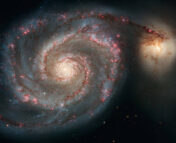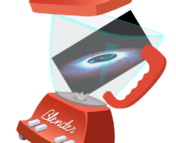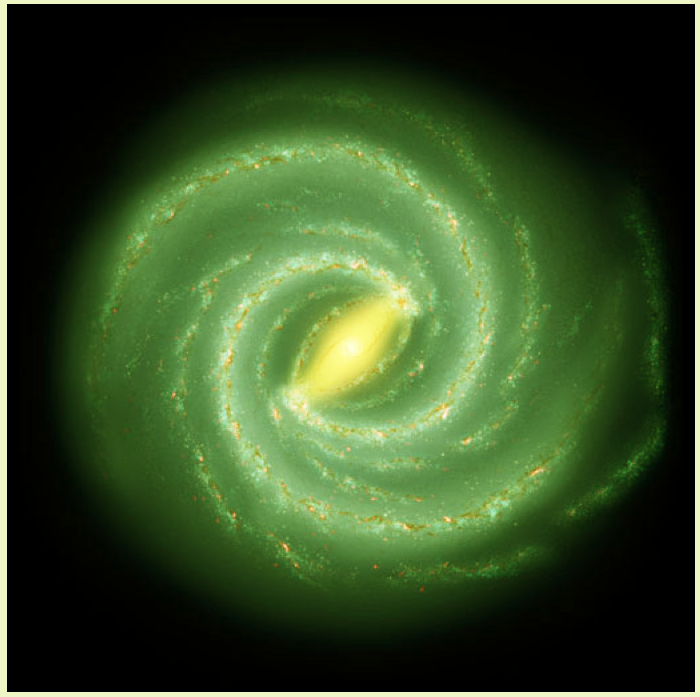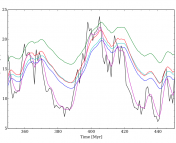Title: Revisiting Galaxy Evolution in Morphology in the COSMOS field (COSMOS-ReGEM):
I. Merging Galaxies
Authors: Jian Ren, Nan Li, F. S. Liu, Qifan Cui, Mingxiang Fu, and Xian Zhong Zheng
First Author’s Institution: National Astronomical Observatories, Chinese Academy of Sciences, 20A Datun Road, Chaoyang District, Beijing 100101, China
Status: Accepted for publication in The Astrophysics Journal [open access]
Galaxies are a bit like LEGO. At least, if you simplify down one of the fundamental theories of Lambda-CDM cosmology, our current best model of the Universe, what you could say is that all structures in the Universe today formed from the merging of smaller structures, much like building up a LEGO masterpiece. So, to build a massive galaxy like our own Milky Way, you need to merge lots of smaller galaxies together first (e.g., see this bite). One day, our galaxy will then collide with our nearest neighbour, the Andromeda galaxy, to form an even more massive galaxy. If you wind back the clock of our Universe, what this simple, fundamental idea predicts is that galaxy collisions were more frequent back in the early Universe. However, this has been a difficult prediction to prove as it requires observations much deeper into the Universe.
Whilst it might seem easy to identify these colossal collisions with nearby galaxies, this gets very difficult for more distant galaxies, i.e., galaxies in the early Universe (since distant = higher redshift = longer lookback time). At these distances, we need better and bigger instruments to resolve enough detail and collect enough light to really identify these more distant and therefore fainter mergers. The authors of today’s paper have used observations of the COSMOS field – an area of the sky that has been extensively observed by multiple cutting-edge telescopes – to identify merging galaxies and investigate their properties.
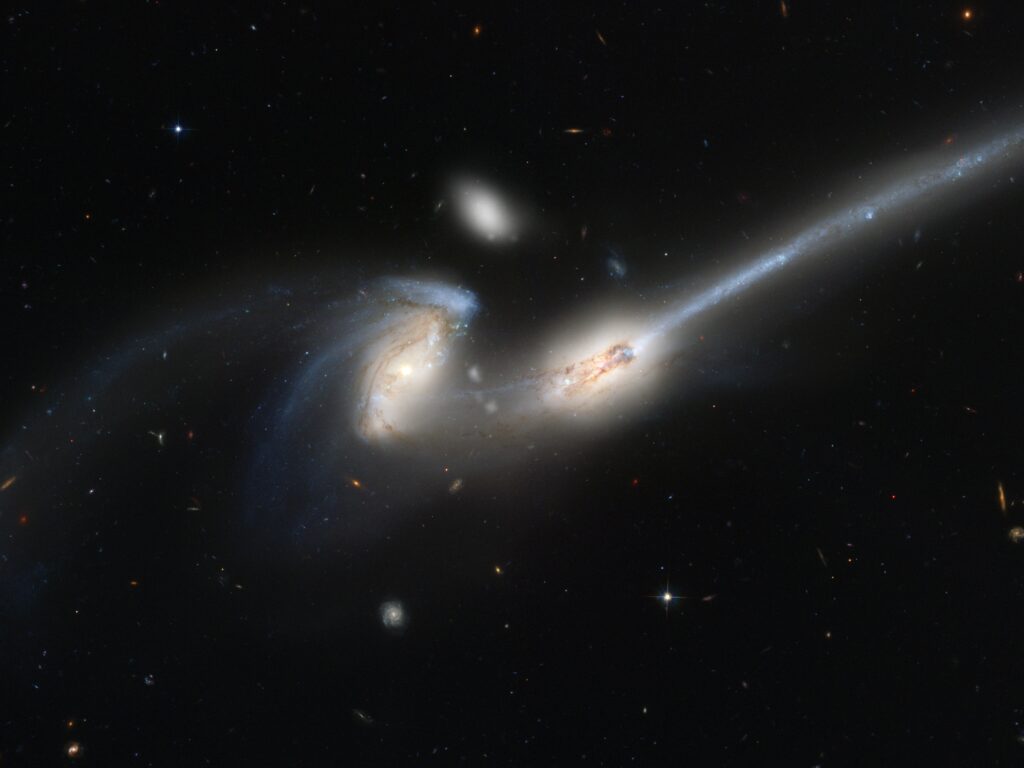
How to spot a merger
There are a variety of different methods to identify merging galaxies. If you have sufficient spatial resolution, meaning you can see the extent of a galaxy rather than just a point source, you often see the evidence just by eye. In Figure 1, you can see a beautiful example of a local merger. These are called the Mice Galaxies, or NGC 4676. This merger is close enough for us to see it in action – the two galactic nuclei are clearly distinguishable, and we can even see a bridge connecting the two, as well as bright tidal tails of stars and gas streaming away from the collision. Similar features are identified in the COSMOS field by today’s authors, some examples of which are shown in Figure 2. In total, 3,594 galaxies out of 33,605 galaxies were identified as mergers by visually inspecting the images and searching for these clues.
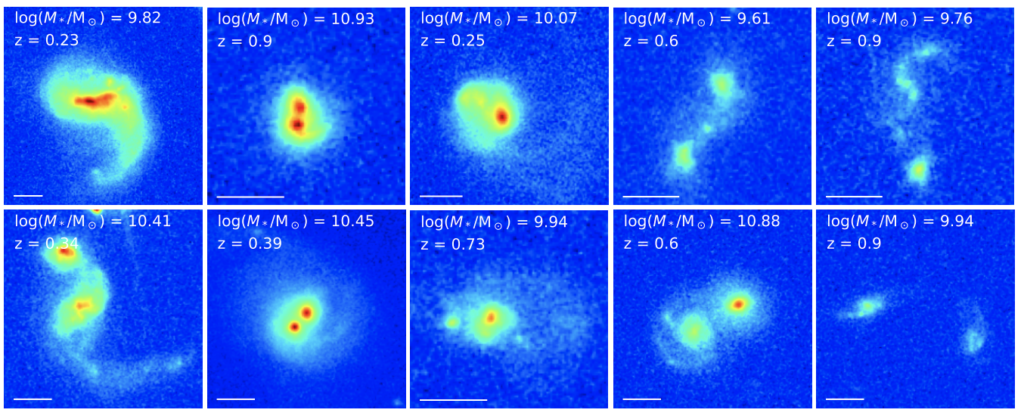
Alternatively, you can also just search for galaxies that are close together, since the expectation is that the forces of gravity will already be in place for an imminent collision. This is useful if you maybe can’t resolve much detail about the galaxies, and instead can only see them as point sources. However, it is not enough to just find two points of light that look close together on an image though, since in that case you are only thinking of things in a 2D space. If you look up at a patch of the night sky, you might see two galaxies that appear close together, but in reality, one galaxy could be a million times further away from us than the other. To check for this pesky problem, you need to know the redshift of the galaxy (again, remember that redshift is often used as a measure of distance from us, the observers). By checking the distances between sources in both the 2D plane of the sky, and according to their redshift, 1,737 galaxy pairs were identified.
Sometimes, however, even this pair method is too difficult. Redshifts can be hard to obtain (e.g., see this bite) and sometimes distances are just too great to even resolve galaxy pairs. For this reason, today’s authors used their impressively huge sample of mergers, pairs and non-interacting galaxies to investigate some alternative methods that could be useful for a higher redshift sample. They find that two parameters in particular, M20 and A0, are especially good at identifying mergers. M20 is a measure of how the brightness is spread across a galaxy, and A0 measures the asymmetry of the outskirts of a galaxy. The images of merging galaxies typically result in much higher M20 and A0 values than the images of non-merging galaxies. This makes some sense – merging galaxies probably should show much less structure and symmetry since these collisions are violent and chaotic.
Mergers across cosmic time
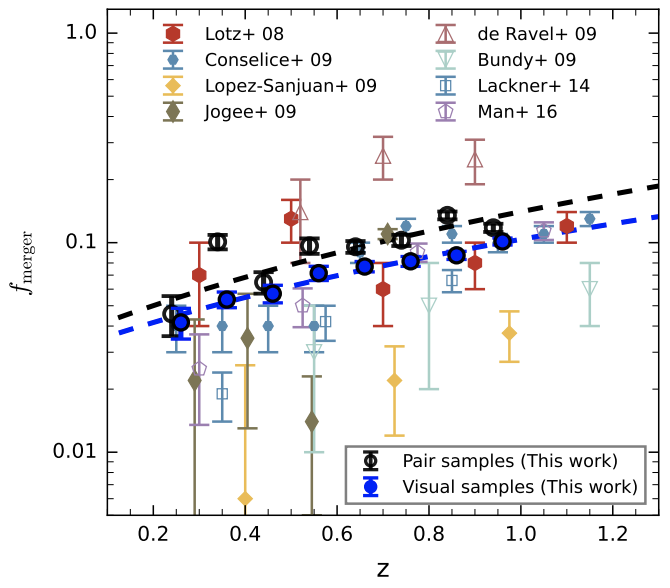
The merging galaxies identified in this work span a redshift range of 0.2-1 – in terms of time, that’s from 2 billion to 8 billion years ago. Counting up all of the galaxies detected in the paper’s observations, and labelling them as merging or not merging via the above methods, , we can see that the merger fraction (number of mergers out of the total galaxy sample) increases as a function of redshift in Figure 3. As predicted, there are indeed more mergers earlier in the Universe. From this evolution, it is estimated that a massive galaxy in the redshift <1 Universe will experience, on average, one major merger every 10 billion years.
Future efforts by the next generation of cutting-edge telescopes, as already begun by JWST, will help to extend this investigation to higher and higher redshifts. Seeing back earlier in time will paint a picture of galaxy mergers at the beginning of the Universe, where the cosmic game of LEGO was likely even more intense and chaotic.
Astrobite edited by Storm Colloms
Featured image credit: NASA, Holland Ford (JHU), the ACS Science Team and ESA.

